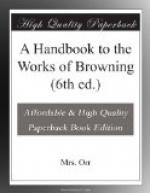After proclaiming the religiousness of Art, Furini is called upon to unfold his theology: and he then passes to a confession of faith in which Mr. Browning’s known personal Theism is contrasted with the scientific doctrines of Evolution. The Scientist and the Believer would as he distinguishes them join issue on the value of the artistic study of man, since man is for both of them the one essential object of knowledge; but the study (artistic or scientific) is, Mr. Browning considers, unrepaying in the one case, while it yields all necessary results in the other. According to the scientist, Man reigns supreme by his intelligence; according to the Believer, he is subject to all the helplessness of his ignorance. In reasoning, therefore, each from his own consciousness, the one finds his starting point at the summit of creation, the other virtually at the bottom of it. The Scientist acknowledges no mind beyond that of man; he seeks the impulse to life within itself, and can therefore only track it through the descending scale of being into the region of inorganic atoms and blind force. The believer refers that impulse to a conscious external First Cause, and is content to live surrounded by its mystery, entrenched within the facts of his own existence, guided (i.e., drawn upwards) by the progressive revelations which these convey to him.
It is so that Furini has lived and learned. He has found his lesson in the study of the human frame. There, as on a rock of experience, he has planted his foot, finding confusion and instability wherever he projected this beyond it; striking out sparks of knowledge at every stamp on the firm ground. He has learned that the Cause of Life is external, because he has seen how the soul permeates and impels the body, how it makes it an instrument of its own raptures and a sharer in them; and he believes that that which caused the soul and thus gifted it will ultimately silence the spiritual conflict with Evil and perfect Its own creation. He believes this because Evil has revealed itself to him as the necessary complement of Good—the antitype through which alone the type defines itself; as a condition of knowledge; as a test of what is right; as a motive to life and virtue so indispensable that it must exist as illusion if it did not exist as fact; because, therefore, its existence cannot detract from the goodness of the First Cause or the promise which that contains.
This constant assertion of the necessity of evil would land Mr. Browning in a dilemma, if the axiom were presented by him in any character of dogmatic truth: since it claims priority for certain laws of thought over a Being which, if Omnipotent, must have created them. But the anomaly disappears in the more floating outlines of a poetic personal experience; and Mr. Browning (alias Furini) once more assures us that what he “knows” of the nature and mode of action of the First Cause he knows for himself only. How it operates for others is of the essence of the mystery which enfolds him. Whether even the means of his own instruction is reality or illusion, fiction or fact, is beyond his ken; he is satisfied that it should be so.




